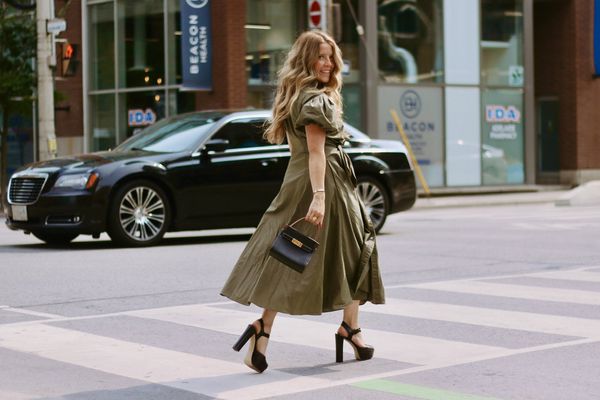
Julianne Costigan, a Toronto stylist who works with women executives, says many of her clients are choosing to move on from heels.Supplied
Early in her career, as a lawyer on Bay Street in Toronto, Lisa Stam would sometimes cram her feet into a pair of spiky heels.
Most courtrooms feature hard flooring, so heels make a loud, intimidating clack on them.
“When you march in with heels, there’s a presence you can have,” says Ms. Stam. “There’s a bit of theatre to law.”
Outside of court, Ms. Stam opted to mainly wear flats paired with pantsuits. Now, she practices employment, labour and human rights law at a small firm where everyone works remotely. “We can all wear bare feet if we want.”




Toronto lawyer Lisa Stam says that laws prohibiting footwear requirements at work may help employees speak up against mandatory heels.Supplied
High heels have been a staple of women’s workwear for decades. But as workplaces become more casual and more people work from home, women are rethinking how footwear impacts their careers and self-image.
Do heels at work make sense any more?
Power and status
The allure of high heels persists in fashion and pop culture. In a recent episode of Sex and the City spinoff And Just Like That, iconic Manolo Blahnik-wearer Carrie Bradshaw (played by Jessica Sarah Parker) bemoaned having to wear flats after hip surgery. In a cheeky scene from blockbuster movie Barbie, the titular heroine played by Margot Robbie debates whether she wants her feet to be permanently on tiptoes in pretty pink pumps or flat in comfy Birkenstocks.
Heels can be a boon to a woman’s image, but they can also hinder her at work. A U.S. study from 2022 found that women in high heels were perceived as more attractive, feminine and higher status than women in flats. On the other hand, studies out of Harvard University found that women in flats were deemed more capable and prepared than those wearing heels in a variety of work scenarios, including giving a presentation, negotiating or interviewing for a job.
Still, many women feel better up high.
“There’s still a very strong perception that when you’re well put together, as a woman or a man, that’s a power move,” says Ms. Stam. “That alone isn’t sexist, but being put together for a woman often involves being sexualized a little.” Heels make your legs look longer and cause you to sway your hips when you walk, notes Ms. Stam.
Julianne Costigan is a Toronto stylist who works with women executives, and she says that heels can influence the wearer’s self-confidence.
“They make you feel bigger and more powerful,” she says. “A lot of women don’t realize [that’s why] they want to wear them, especially for big meetings.”
Toes under pressure
For women who do like wearing them, do high heels ruin your feet?
“They don’t do any good,” says Toronto chiropodist Shannon Hardy. Patients who wore them for years for office and service industry jobs often have bunions, deformed toes and ruined nails, she adds.
An American Podiatric Medical Association survey found that 71 per cent of women who owned high heels said they hurt their feet. The APMA also said that wearing high heels all day can cause the wearer’s Achilles tendon to shrink, increasing the risk of injury. Dr. Hardy says that high heels put too much pressure on the forefoot and can change a person’s gait. Many of these shoes have pointy toes too, which can crowd feet and lead to bunions.
Dr. Hardy notes that you can’t wear heels for a few weeks and repair your feet by compensating with time in Birkenstocks. “You won’t undo what you did. You can’t reverse the damage.”
The right to go flat
Not long ago, some workplaces had dress codes that insisted women wear heels. A U.K. survey conducted in 2016 found that, among 2,000 office employees, seven per cent were being asked to wear heels and eight per cent were urged to apply makeup; 28 per cent were told that changing their appearance would be good for business.
In 2017, B.C. and Ontario passed new laws that forbade workplace dress codes with footwear requirements unless it was for safety reasons. Manitoba and Alberta followed a year later with laws of their own. (Women working in entertainment can still be asked to wear heels as part of a costume, however.)
Ms. Stam says having different rules for women and men at work is in violation of long-standing human rights laws but, prior to these law changes, it was difficult for employees to speak up.
“It affects job security. How are people going to complain about these things prior to a legal change?” she says, noting that precariously employed women in the service industry were particularly affected.
Questioning workplace conventions
In an increasingly work-from-home world, more women may feel free to ditch their heels.
“The pandemic influenced perception of what was acceptable to wear in the workplace. Things were a bit more formal pre-COVID, and we’re seeing things relax a little bit,” says Ms. Costigan.
The popularity of hot-desking, where people share desks in their workplace instead of having their own, means there’s no bottom desk drawer to stuff “meeting heels” in.
“It’s now less about people changing into different shoes,” says Ms. Costigan. “The shoe they wear in the morning is the shoe they wear all day.”
Ms. Costigan says many of her clients, who skew older, are questioning workplace fashion conventions – and for some, that includes moving on from heels. “The common thread among my clients is many get to this age where they finally decide to just stop trying so hard, and who they are is good enough.”
Slow progress
If women do choose to wear heels, Dr. Hardy recommends shoes with a heel under three inches and a wider toe box. She notes that numerous brands now design heels for comfort and overall foot health.
Alternatively, wedge heels and platform loafers and sneakers are gaining in popularity.
“I’ve been leaning into these choices that give you a bit more height without the heels,” says Ms. Costigan, who loves blinged-out platform sneakers.
She notes that women are looking fabulous in a wider array of footwear, as outdated ideas about fashion and workwear slowly change.
“I think we are making progress,” says Ms. Costigan. “That’s the best we can do. Moving the needle and making sure those old standards aren’t standards any more.”




Interested in more perspectives about women in the workplace? Find all stories on The Globe Women’s Collective hub here, and subscribe to the new Women and Work newsletter here. Have feedback? E-mail us at GWC@globeandmail.com.
This post was originally published on this site be sure to check out more of their content.





